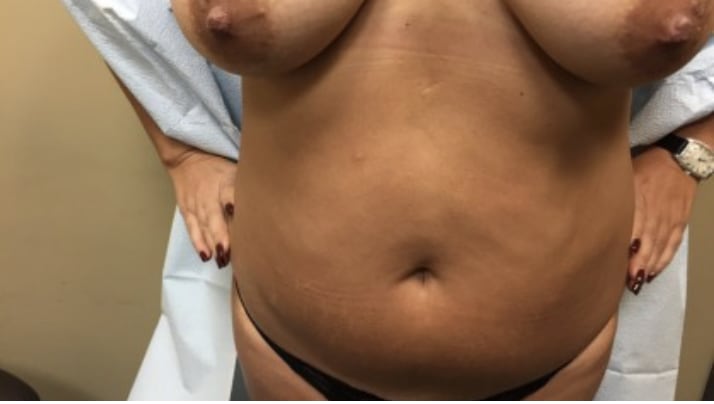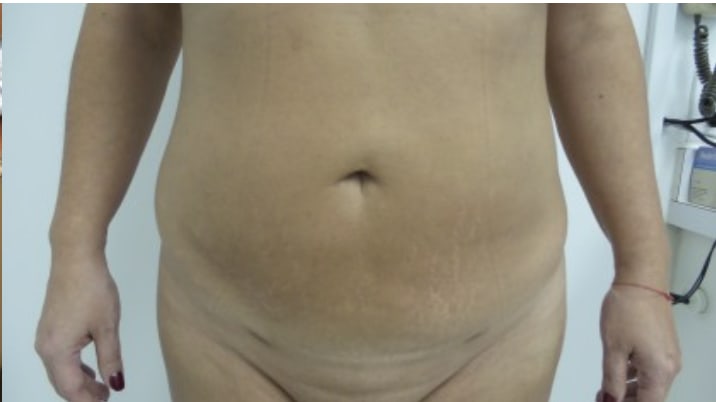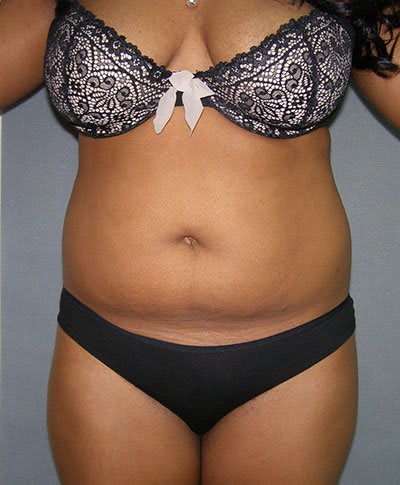
The Skinny
Overview
Fat is essential to life and our bodies are designed to store it. However, in this age of low-nutrient, convenient, high-calorie foods, many people store more fat tissue than they need. Fat can be stored in the butt, thighs, abdominal area, back, and even in the cheeks.
Liposuction is a safe body contouring cosmetic procedure that removes excess fat and reshapes the body in targeted areas. It helps to reduce the risks for heart disease, stroke, diabetes, and other weight-related health conditions and very often increases the patient’s self-confidence.
This article reviews the goals of liposuction, some of the pros and cons associated with it, and who makes a good candidate for having it performed. It also looks at the different types of liposuction procedures that are available, discusses some before and aftercare tips, and finally, reviews the risks and possible adverse effects associated with this safe but serious surgery.
AEDIT
Before & After Images by Provider
This Album Contains Explicit Content. Sign up or Login to Browse Real Before & Afters
Before & After Images by Provider
Liposuction Solutions
The Specifics
Goal of Liposuction
The goal of liposuction is to remove stubborn fat deposits, most commonly on the stomach, hips, back, and thighs. The procedure is a potential solution for those wishing to reshape their body contours to enhance their overall attractiveness. It is often performed along with other “mommy makeover” procedures like breast augmentation or a tummy tuck. Liposuction can also be used for breast reduction in women with large, heavy breasts; and for removing excess fat tissue in men with feminized breasts, a medical condition called gynecomastia.
Pros & Cons of the Procedure
Liposuction has been one of the most popular body contouring procedures for decades. Most patients feel that there are few downsides associated with it.
As with all elective cosmetic surgeries, one primary limiting factor is cost. The American Society of Plastic Surgeons reports that the average cost of liposuction in 2017 was $3,374. Note that this fee is a national average that varies widely depending on various patient-dependent factors, like the size of the treatment area, cost of anesthesia, and the surgical facility where it is performed, for instance.
Some other “cons” of liposuction are:
The American Society for Aesthetic Plastic Surgery (ASAPS) reports that 90.8% of patients report being satisfied with the results they achieve with liposuction. Some notable pros of this procedure are:
Discuss the unique benefits liposuction may have for you with a board certified plastic surgeon who specializes in this safe, outpatient procedure.
Cost of Liposuction
The average cost of a liposuction procedure according to the American Society of Plastic Surgeons (ASPS) was $3,548 in 2019. Liposuction cost will vary significantly due to numerous variables. When considering booking a procedure, these other possible expenses can start to add up. To learn more, check out our complete guide to liposuction costs.
Before and Aftercare
If you decide that liposuction is for you, then you will need to schedule an initial consultation with a board certified plastic surgeon who specializes in the procedure. If you are a good candidate for having liposuction, the doctor may ask you to do the following before the surgery date:
Remember to arrange for someone to drive you to and from the surgical facility or hospital where your surgery will be performed. You might also need to schedule time off work, depending on the severity of the treatment you have.
You will likely come out of the surgery room with bandages and compression garments over your incisions sites and surrounding areas. Temporary surgical drains are also used commonly to evacuate any remaining tumescent fluid and to keep blood from building up under the skin. The doctor will tell you how and when to clean or change these drains, dressings, and garments.
You will also be prescribed pain medications, anti-inflammatory drugs, and antibiotics as needed to help you manage the normal signs of healing like bleeding, bruising, pain, swelling, and tightness. You will return to see the surgeon in follow-up visits to have stitches removed and make sure you are healing properly. It can take several months to recover completely and see the full results in treated areas.
Ideal Candidate
Liposuction continues to be one of the most popular cosmetic surgery procedures. It is considered safe for good candidates and is well-tolerated by most patients. You may be a good candidate for liposuction if you are not more than twenty pounds overweight, do not smoke tobacco products, are mentally stable, have good skin elasticity, and have a positive mental attitude and realistic expectations about the procedure and its risks.
Liposuction is not recommended as a remedy for being overweight or obese. It is also not meant for cellulite removal. Your surgeon may advise against this procedure if you have a medical condition that could inhibit your ability to heal.
Types of Liposuction
Liposuction techniques have been evolving for decades. Modern lipoplasty involves various possible approaches for removing stubborn adipose tissue. Although it is considered safe for most good candidates, there are still risks for minor and major side effects.
In general, liposuction involves making small incisions in strategic locations that allow large volumes of fat tissue to be vacuumed out. The suction wand used in liposuction is called a cannula. Modern variations in liposuction technologies include:
Tumescent Liposuction
Intumescent lipoplasty, the fat tissue to be removed is first inflated with an isotonic liquid solution. This mixture typically contains a vasoconstrictive agent called epinephrine that reduces the risks for hypertension (high blood pressure) and tachycardia (abnormally rapid heartbeat), while also keeping blood loss to a minimum during the procedure.
The solution also contains saline and a local anesthetic agent called lidocaine. The tumescent technique is popular because it allows for large volumes of fat to be removed without the need for general anesthesia.
Power Assisted Liposuction
This type of lipoplasty uses a tumescent solution but a specialized cannula is used which vibrates to accelerate the breakdown of the adipose cells. The vibration in the cannula makes it easier for the surgeon to fragment the fat. This allows for the procedure to be completed in less time, causes less tissue trauma, and allows for faster recovery times in many patients.
RF Assisted Liposuction
RFAL™ employs the use of a cannula that emits radio frequencies into the treatment area. The RF waves make fat removal easier and help to tighten the skin. RFAL™ systems like Necktite and Bodytite™ have been shown to increase skin elasticity between 30-40%. This type of liposuction is generally used on the buttocks, hips, thighs, and stomach.
Ultrasound Assisted Liposuction
UAL systems like Vaserlipo® are mainly used on the thighs, hips, back, and stomach. This technology combines tumescent liposuction with ultrasonic frequencies that break down and dislodge fat cells before tumescent liposuction is performed. This allows more adipose tissue to be suctioned out. This type of liposuction can be useful for tightening the skin in patients with mild skin elasticity challenges.
Laser Assisted Liposuction
LAL systems like CoolLipo™ and SmartLipo™ help to “melt” fat tissue with laser energy before removing it with suction. This aggressive type of liposuction can be used in most areas of the body. It also has a skin tightening effect and does not typically require the use of general anesthesia.
Water Assisted Liposuction
WAL is used to improve the effects of tumescent liposuction by gently spraying water to dislodge fat cells before suction. This allows more fat to be harvested with less trauma to surrounding tissues. This technology is typically called “aqualipo”, or by its brand name, Body Jet®.
Liposculpture
This type of liposuction is commonly referred to as abdominal etching because it is often performed on the stomach. However, it can also be performed on the chest, thighs, calves, arms, and other body areas that have accumulated fat deposits. The technique involves leaving some fat tissue behind during liposuction to create the appearance of defined muscles.
Recovery
To better understand the healing and downtime associated with the procedure, check out our complete guide to liposuction recovery.
The Takeaway
Conclusion
There are several types of liposuction surgery that are safe and effective for removing stubborn fat deposits in the body. This surgical procedure requires only small incisions and allows for a quick recovery period in most patients. However, there are some possible side effects to be aware of including the risks associated with the use of anesthesia. Infection, damage to blood vessels and nerves, prolonged discomfort in treatment areas, and botched results are also possible.
If you are considering liposuction it is important to research the procedure and develop a realistic understanding of what it can offer and its limitations. Lipoplasty is not a remedy for obesity or a substitute for healthy weight loss. Rather, it is a treatment option for removing stubborn fat deposits that do not respond well to diet and exercise.
Ask all the questions that you have in mind during your initial consultation appointment with your surgeon, and make sure that you and the doctor have a good rapport together. The decision to have any type of cosmetic surgery is an important one that will affect you for the rest of your life. Take your time making the best decision possible.











